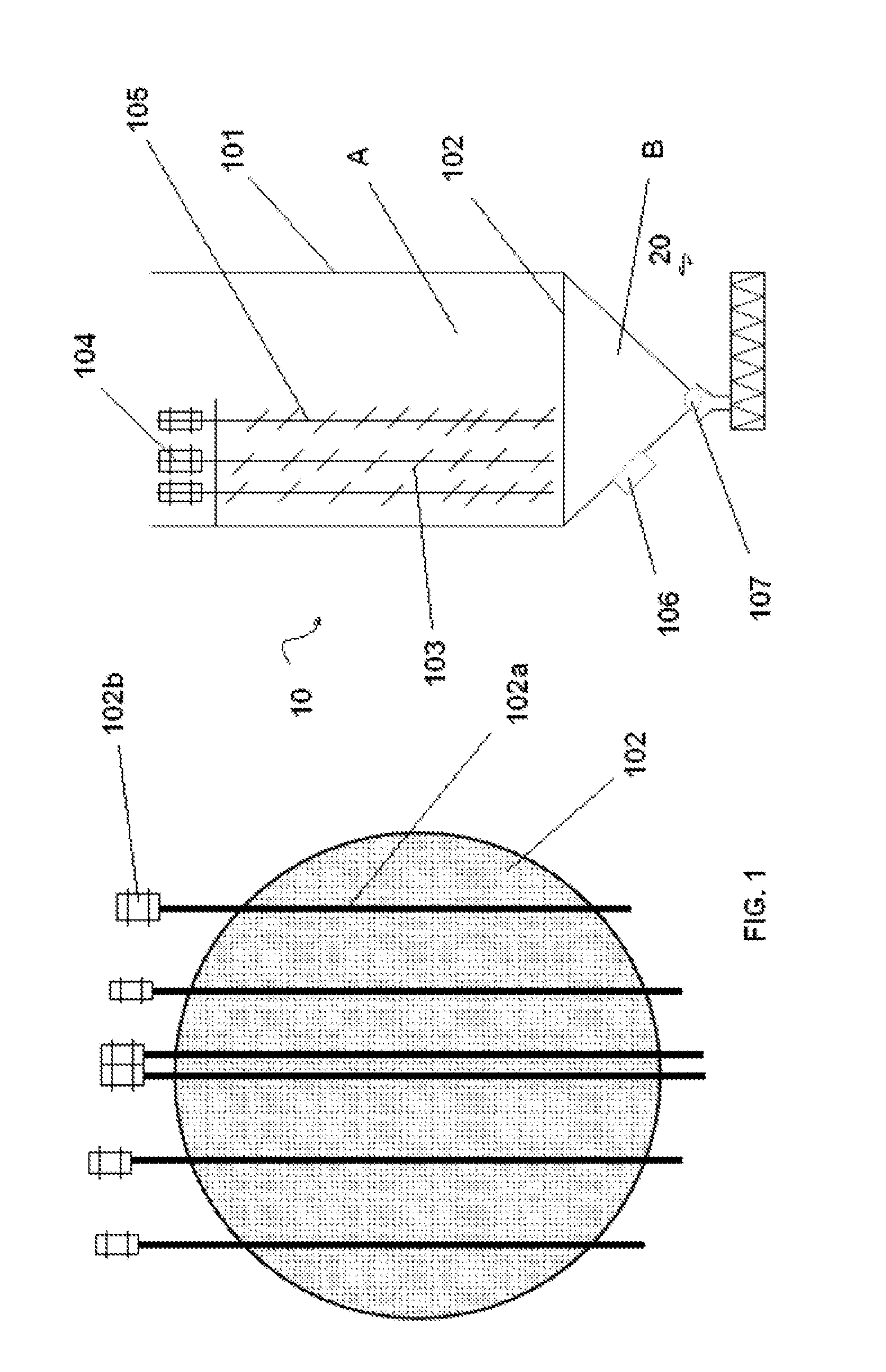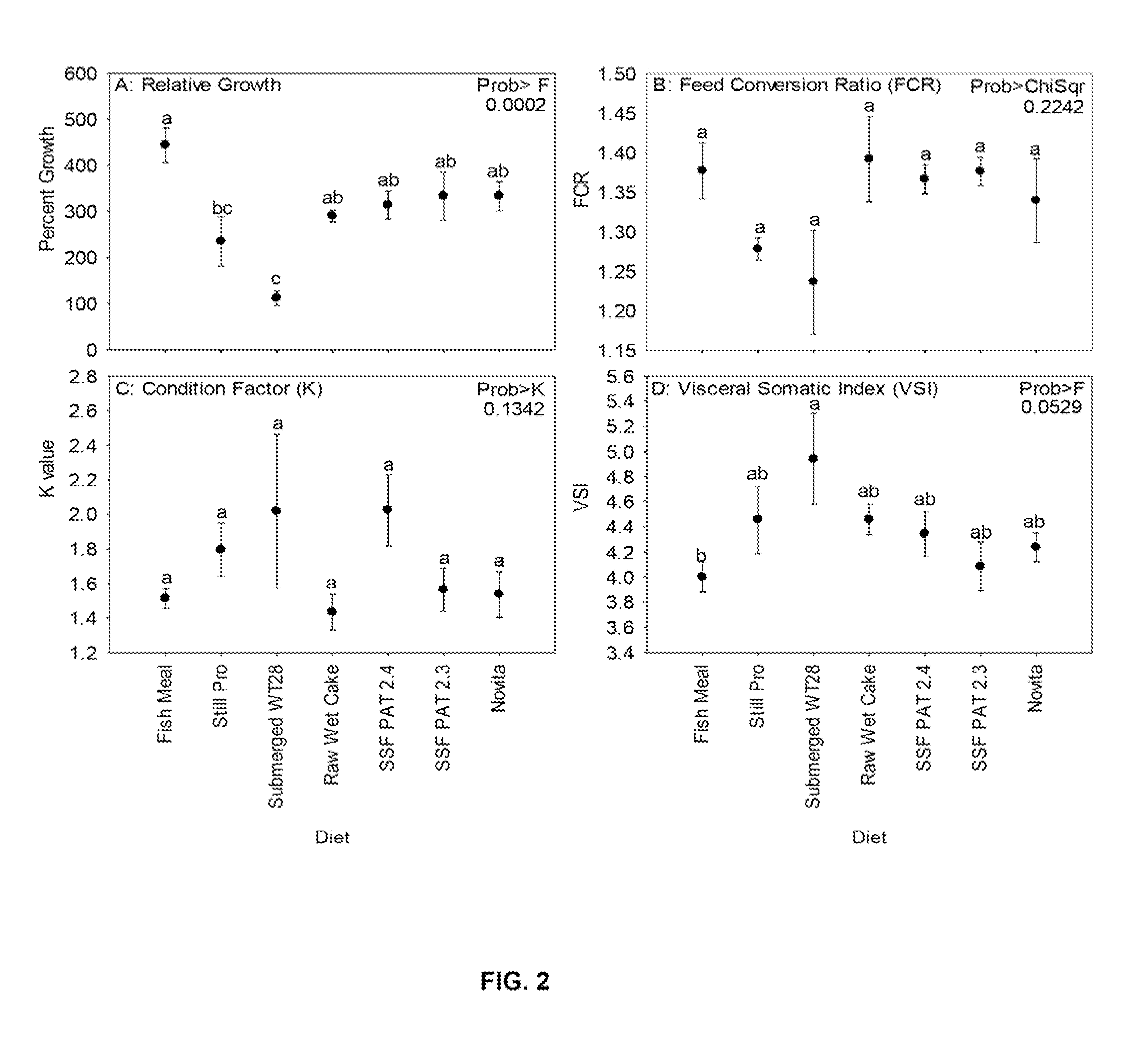Solid State Fermentation Systems and Process for Producing High-Quality Protein Concentrate and Lipids
a technology of solid-state fermentation and protein concentrate, which is applied in the field of solid-state fermentation processes to produce high-quality protein concentrates and lipids, can solve the problems of current solvent extraction process cost, deficiency of critical nutrients (e.g. taurine) required by carnivorous marine fishes, and unsustainable trend
- Summary
- Abstract
- Description
- Claims
- Application Information
AI Technical Summary
Benefits of technology
Problems solved by technology
Method used
Image
Examples
example 1
Production of 1st Generation HP-DDGS
[0157]In a pretreatment evaluation, DDG was extruded in a single screw extruder (BRABENDER PLASTI-CORDER EXTRUDER MODEL PL2000, Hackensack, N.J.) with a barrel length to screw diameter of 1:20 and a compression ratio of 3:1. DDG was adjusted to 25-30% moisture, the extrusion temperature was set at 175° C., and screw speed was set at 50 rpm, providing a shearing effect against the ridged channels on both sides of the barrel. This was referred to as extrusion method 1. These selected levels of temperature, screw speed and moisture were based on optimized conditions defined previously for defatted soybean meal.
[0158]Extruded DDG (50 Kg) was then mixed with 450 L water to achieve a solid loading rate of 10% in a 600 L bioreactor. The pH was adjusted to 5 and the slurry was heated. After cooling the slurry was saccharified using a cocktail of enzymes. The temperature was then reduced, the pH was adjusted to 3.0 (to optimize cell growth), and the slurry...
example 2
Hybrid Solid State Fermentation (hybrid-SSF) Trials in the Omcan Reactor (˜100 L)
[0190]A feed stock was selected from the following list: soybean meal (SBM), extruded soy bean meal, DDGS, extruded white flake, or Novita Novameal. Then a 15% solid loading rate of the feedstock was added to a submerged bioreactor with distilled water to reach a total of 5 L. magrabar antifoam (2 ml) was added, and the pH was adjusted to the desired level (typically 3-5) using concentrated sulfuric acid. After autoclaving at 121° C. for 30 minutes, the material was cooled to 1) 50° C. if a saccharification phase was to be conducted or 2) 30° C. if the saccharification phase was omitted. When saccharification was used, Novozyme enzymes Htec2 (3 ml) and Ctec (5 ml) were added and the slurry was agitated at 200 rpm for 24 hr. After cooling to 30° C., the slurry was inoculated with 50 ml of a 24 culture of inoculum grown on a 5% glucose, 0.5% yeast extract medium. Cultures tested included: A. pullulans sp....
example 3
Production of PUFA Using Microbial Conversion
[0207]Expeller extracted soybean meal with about 5% fat remaining was used. The moisture content of the material as received was about 10%. The pH and moisture content of the soybean meal was adjusted by premixing the appropriate amount of water and acid. As an example, 8.8 kilograms of soybean meal was measured out. Separately 410 grams of concentrated sulfuric acid was mixed into 6 liters of water. The meal and acid solution were then mixed together thoroughly in a horizontal paddle mixer. The pH was then verified to be close to the target of 3.0. Then next step was to add 1 liter of prepared T. aureum inoculum and mix thoroughly again. The mixer was set on a timer so that it would mix for 5 minutes every 3 hours. The fermentation process was allowed to proceed for 144 hours. The material was dried down in a low temperature oven and saved for analysis.
PUM
| Property | Measurement | Unit |
|---|---|---|
| Temperature | aaaaa | aaaaa |
| Temperature | aaaaa | aaaaa |
| Fraction | aaaaa | aaaaa |
Abstract
Description
Claims
Application Information
 Login to View More
Login to View More - R&D
- Intellectual Property
- Life Sciences
- Materials
- Tech Scout
- Unparalleled Data Quality
- Higher Quality Content
- 60% Fewer Hallucinations
Browse by: Latest US Patents, China's latest patents, Technical Efficacy Thesaurus, Application Domain, Technology Topic, Popular Technical Reports.
© 2025 PatSnap. All rights reserved.Legal|Privacy policy|Modern Slavery Act Transparency Statement|Sitemap|About US| Contact US: help@patsnap.com



